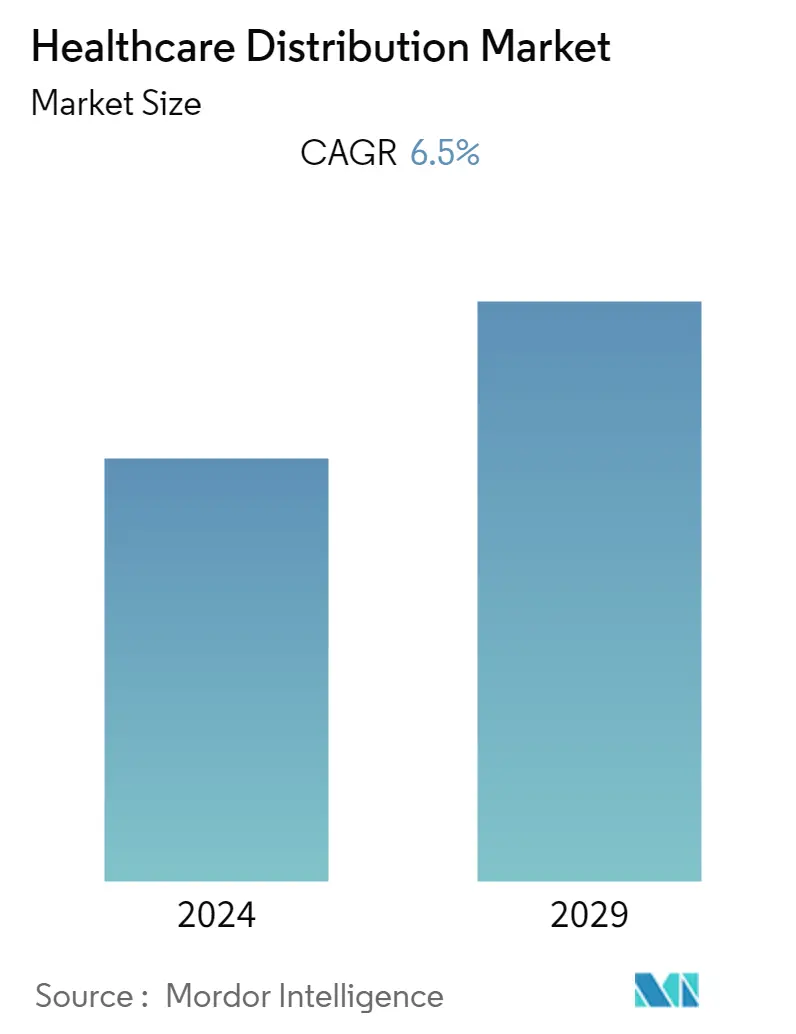Market Size of Global Healthcare Distribution Industry

| Study Period | 2018 - 2028 |
| Base Year For Estimation | 2021 |
| CAGR | 6.50 % |
| Fastest Growing Market | Asia-Pacific |
| Largest Market | North America |
| Market Concentration | Medium |
Major Players
*Disclaimer: Major Players sorted in no particular order |
Need a report that reflects how COVID-19 has impacted this market and its growth?
Healthcare Distribution Market Analysis
The healthcare distribution market is expected to register a CAGR of 6.5 % over the forecast period, 2022-2027.
COVID-19 pandemic was an incomparable global public health emergency, it has impacted almost every sector of the industry including the healthcare distribution market industry. The strict lockdowns and government regulations intended to slow down the spread of COVID-19, by restricting the movement of people. Lockdown has impacted the sales of the healthcare distribution market initially but over some time market has gained significant growth. For instance, in 2021 an article published in the journal, Maritime Economics, and Logistics, summarizes that COVID-19 impacted the manufacturing activity and caused disruptions in transportation and logistics activities globally, these factors lead to a sudden and drastic fall in the healthcare distribution services. Within a few weeks of the COVID-19 crisis a considerable change in consumer behavior and demand, consumer purchase patterns, re-routing of the supply chain, and significant government intervention was observed. The supply chain disruptions during the initial phase of lockdown were a major downfall for the distribution market resulting in a slowdown in the healthcare distribution activities and this led to setting up a strong supply chain network for efficient healthcare distribution services. The disease will inevitably be an overwhelming burden on healthcare systems that cannot be effectively dealt with by existing facilities or responses based on conventional approaches. All these long-term effects of COVID-19 have caused challenges for healthcare distribution services.
With the large economic burden of chronic diseases, technological advancement in distribution, favorable R&D investment scenario, and subsequent increase in drug launches are the main driving features of the healthcare distribution market. For instance, in 2022, the National Institution of Chronic Disease and Data reported that nearly 60% of adult Americans have at least one chronic disease and about 40% of American adults have multiple chronic conditions (MCC). Chronic conditions like diabetes, cancer, and cardiovascular disease are the leading causes of death in the United States. To cure these disorders, cellular treatment, biomarker imaging, generics, biosimilars, and other wide range of healthcare medications are used. These created necessities for effective healthcare distribution services. Generics are also in high demand due to their cost-effectiveness. Furthermore Thus, increasing cases of chronic disease are driving the healthcare distribution market.
The growing need for medical device equipment such as in-vitro diagnostic equipment, diagnostic imaging equipment, and endoscopic equipment which are used in this healthcare industry for a variety of functions is driving the above market. Thus a safe and effective delivery network in the healthcare distribution market is required which can fulfill the need of consumers and thus can significantly aid the market growth. Technological advancements in distribution are boosting the healthcare distribution market. For instance in 2021, according to the article published in ScienceOpen.com titled, Applications of Artificial Intelligence (AI) Healthcare: A review summarizes that with the coming of technologies such as Artificial Intelligence, machine learning, and other technologies, the healthcare distribution market sector has witnessed an advanced change. Adopting IoT (Internet of things) technologies has given distributors real-time information about their pharmacies and provider clients. This allows them to provide with consistent supply schedule. IoT (Internet of things) technology also has diversions by algorithms to assess if the delivery route is not followed or if an unusual delay had occurred. Due to this advanced technology and safe and effective delivery tracking system, there is increasing growth in the healthcare distribution market.
Advanced technologies and increased chronic disease cases are the factors likely to boost the adoption of the healthcare distribution market, thereby contributing to the studied market growth. Therefore, owing to the aforementioned factors the studied market is anticipated to witness growth over the analysis period. The high cost and investment associated with the healthcare distribution services are expected to hamper the overall growth of this market.
